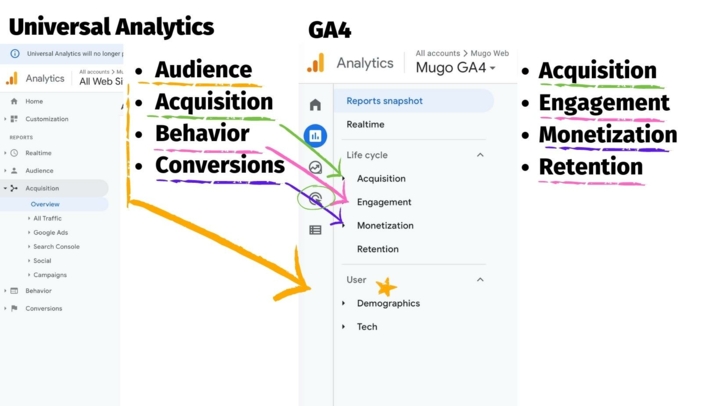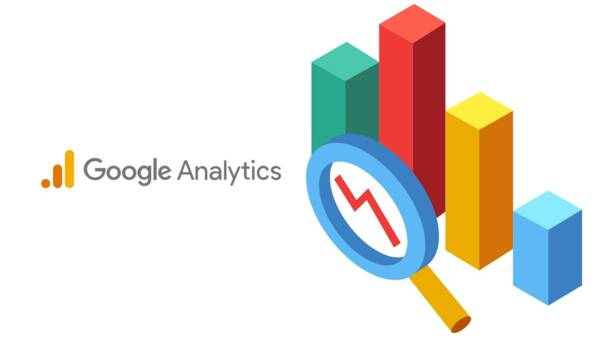An introduction to what's coming with GA4, or: How I learned to stop worrying and love analytics
By: Bethany Morse | October 27, 2022 | GA4, marketing, and google analytics
If you have a Google Analytics property, you’ve probably heard about the upcoming switch to GA4. You might have seen the banners across the top of the page when you log into UA. “Universal Analytics will no longer process new data in standard properties beginning July 1, 2023”, a polite yet vaguely threatening notification, easily ignored as a problem for next year. If you are proactive, you might have already started the switch to the new platform, having heard the recommendation to run both concurrently until the switch. And if you are like many, that might be as far as you’ve gotten.
GA4 is very different from Universal Analytics. At first glance, the interface is similar, but under closer observation, the tools you are familiar with are gone, the vocabulary is different, and what on earth do they mean about AI-driven analytics, anyway? Why does everything online have to change just when you've gotten comfortable with the old version?!
If that's where you are with the GA4 switch, we've got you covered. Over the next few months, we'll look into new features in this blog series and explain some of the changes. By the time GA4 officially takes over, you'll be comfortable navigating your site's data streams and have all the information you need at hand.
Facing the existential dread of changes on the internet
First of all, why is this switch occurring, anyway? GA4 provides several advances in tracking your site's data, ultimately resulting in more accurate numbers. Not all change is bad! GA4 gives you more control over how you organize your data. It provides the option of customized reports and flexibility in what you are tracking. It allows you to explore just how your audience engages with your site ("engagements" are one of those new vocabulary changes, and doesn't it sound more pleasant than "behavior"?). It also consolidates all your data streams (the separate properties for your app and website) into one platform. If your business has a website and an app, you can view them together. These are helpful changes.
But usability and accuracy aren't the only driving forces behind the changes. Privacy concerns are a big one, and the changes brought about by those concerns are likely to cause you the most headaches when it comes to GA4 if you aren't prepared to rethink how you use your analytics. The internet is ultimately a relatively new invention, and governments are still just getting a handle on how they regulate it. Internet Privacy is a growing concern for consumers (and thus legislators). The EU's General Data Protection Regulation (GDPR) and California's Consumer Privacy Act (CCPA) are two landmark forms of regulation. These have already changed how online companies do business, and remaining compliant will require even more changes as we see more states and countries considering similar bills.
This also is not a bad thing! We all want our data to be secure. But we'll have to make adjustments to live in the world we want. Here's a hard truth: things like third-party cookies will eventually disappear in the long run. And businesses like Google, who make their money on tracking and analyzing internet data, need to be prepared to provide value-added alternatives. Many of the changes in GA4 are designed to protect user data and identifying information, specifically to comply with GDPR to a greater degree. It's hard to regulate the world wide web when laws change across geographic borders that don't have the same significance online. So— what are the specific changes coming to GA4, and how does this affect you?
How do I find my old reports from UA?
At first glance, the interface in GA4 doesn't look that different from UA. The menu is tidier and has similar terms, though it seems a bit rearranged. Once you start diving in, you begin to see the main differences. Both have real-time reports, where you can see who is currently using your site and where from. UA's menu takes you to 4 central dashboards, each with multiple accordions and dozens of different report options you can dig into. Audience, Acquisition, Behavior, and Conversions were where you would find most metrics you could want. In GA4, you have Acquisition, Engagement, Monetization, and Retention. The correlation between the UA & GA4 menus is not one-to-one, but they have similarities.
There are fewer menu options under each of those headings in GA4, but that's because GA4 is designed to enable the user to build custom reports through Explore. The snapshot page for each menu option still has a wealth of different metrics and reports, the order and view of which can be customized to provide you with a dashboard that best suits your needs. That's a handy feature. As for the rest, there are some reports you'll have to work a bit to set up in GA4 using customized events.
Why should I care that GA4 uses Events vs. Sessions?
Events, on the surface, are a pretty cool update that allows you to gain a bigger picture of how visitors use your website. They are touted as a shortcut to using heavy code or tags in GTM. And they are that— to a degree. Each GA4 property starts out with a set of events that serve as a baseline for most websites. Some may not apply to your site and likely won't fill all your needs alone. Luckily, Google also provides a handy database of additional recommended events that can be easily added for individuals familiar with GTM. Each event tracks a different action (or engagement) that users take when on your site. Enabling the events to trigger based on those actions allows you to track things like content selections, logins, purchases, and more. Switch key events to conversions, and you can highlight specific marketing goals to see results in real-time.
But the real power behind events is that they are entirely customizable using the Configure menu in GA4. And if customizing existing events from the recommended list still doesn't get you what you need, you can even build your own events from scratch. You'll just need to be comfortable diving into Google Tag Manager for this second option. If this isn't your bailiwick, then you might want the help of a development partner to help make sure all the triggers you want are firing accurately and to troubleshoot the process. Once all that is set up (yet another reason why running GA4 before July will help you out), you'll be pulling data more relevant to your business plan and marketing needs.
Don't worry— we'll cover several examples of this in upcoming posts, and if you want a development partner to help shepherd you through the process, I've got even better news for you. Mugo Web is happy to talk to you about your project.
But how is GA4 actually tracking users?
Previously, UA's primary tracking was when a user visited your site. It could then follow them for each page they visited during that session as long as they were on the same device. That's useful for raw numbers but doesn't necessarily tell you how that user interacts with the pages they were on. It also isn't remarkably accurate, given how people tend to use the internet today. Folks don't only sit down at a desktop computer to access a website, particularly one they use often. They might do that, but they will also look it up on their phone. They might even start a session on their computer and transfer that same session to their tablet. In UA, those would be different sessions or possibly reported as other users. While that makes your numbers look great, it's not accurate.
How does GA4 address this? It's attempting to remove duplications by better integrating a range of identifying metrics besides IP addresses. Google is doing some work here by tracking devices (with cookies enabled), Google Signals, and User IDs. Google Signals uses the data from individuals who already have Google accounts and— this part is key— have enabled ads personalization. That means Google can track them more easily and already has (tacit, as many people don't realize they can turn this off) permission to do so. Google kindly shares this (anonymized) data with your analytics data stream.
User ID, however, is something that you will have to configure. It uses the USER_ID tag to create a dimension for tracking in custom reports. It only works if your site uses account logins that you've properly identified in GTM. The clever part it does is recognizing what events are done on the same device before and after login. For instance, an individual engages with open content on their computer before logging in. They hit the paywall (within the same session) and then log in to their account to finish reading. Even though initially, the first actions aren't registered by the User ID tag, the tag is retroactively applied after logging in. This does give you better metrics and allows you fairly comprehensive comparisons between users with accounts and those without. You'll have to do a little work to get those.
How are there better privacy protections while tracking individual users more closely?
As already mentioned, compliance with things like the GDPR is a contributing factor in the switch to GA4. How exactly is that working when considering claims that GA4 is more accurately tracking individuals? Google has expressly set up protections for site users in the EU. All data collected from those users is stored only in data centers within the EU and anonymized before being sent to specific data streams. Most data collection is being handled regionally, and users have more options to opt-out of tracking. Property owners have more control over what data their sites are tracking (which means, yes— compliance is being outsourced to you, so perhaps brush up on local laws). Property owners also can delete specific user data from their analytics upon request (which only takes 24-48 hours to process).
All of that happens in the background, though. Perhaps the most significant change regarding consumer privacy you will see as you explore your data is that analytics will no longer store identifying user information for over three months. All those custom audiences and User IDs you set up will not give you a full year-long retrospective. They will still trigger, but if you look at a more extended period in your custom reports, you'll see a friendly error message alerting you that the data doesn't exist beyond that period.
Convenience not just for convenience's sake: how GA4 integrates with other Google properties
Google isn't just making all these changes to make a better product or legal compliance, although both of those are actual reasons for the shift and valid ones. But let's face it— Google also wants to make money. Several of the services associated with GA4 were previously only available for paid subscribers of 360 Universal properties and will now be free for all users under the standard package. So, what does Google get out of this? It all comes down to ads. The integrations in GA4 with Firebase, the ability to create custom audiences for your site, and the better tracking of individual users amid the cookie's demise all allow GA4 data to work seamlessly with your Google Ads account for better bids in your marketing campaigns. This does work in your favor, too. Better targeted ads mean (ideally) a better return on investment.
Ready for the next steps?
Ok. Now that we know some of the whys and hows behind the move from Universal Analytics to GA4, it's time to jump into the deep end.









